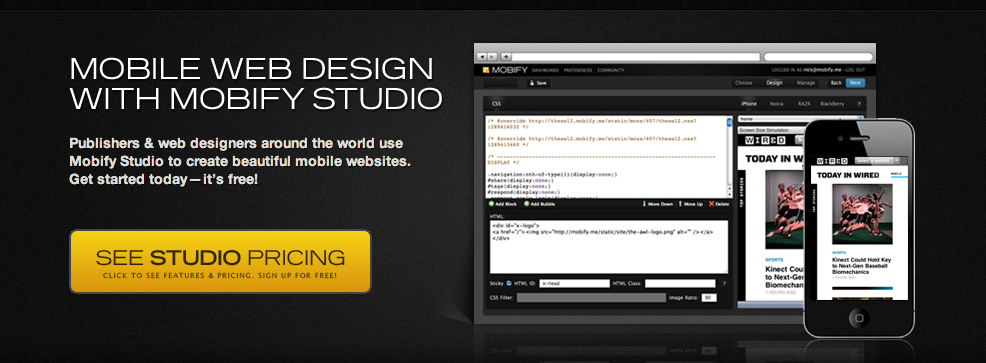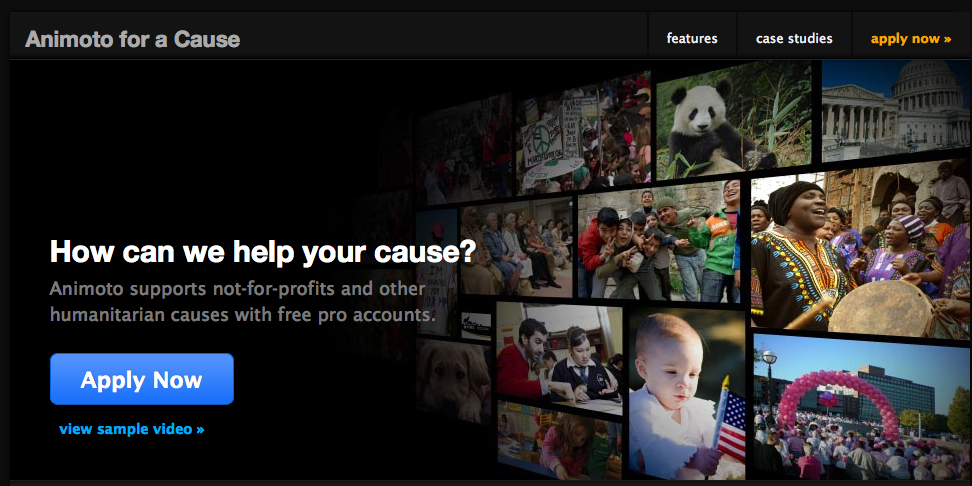Guest post by Erica Holt
These are frugal days, and everyone loves getting and writing about free stuff.
(Wait for it…)
Relax, I’m not going to re-list what’s already been written all over the Interwebz about affordable technology available to non-profits.
Instead, here are four completely awesome tools I love that don’t seem to get the attention they deserve.
Image: Brad Stabler via Flickr, CC 2.0
As smart WUL readers know, technology does not equal strategy, and it won’t solve all your organization’s problems.
I also don’t recommend implementing tools willy-nilly because they are free.
But if technology can help you meet your goals, and the cost is time, not money, you might want to check out these tools (if you haven’t already) that can come in very handy for those on a shoestring budget.
1. Mobify
Given the huge uptake in mobile web use, you know by now that if your site isn’t optimized for mobile devices, you are likely missing out on opportunities left and right to connect with your audiences.
But creating a well-designed mobile version of your site from “scratch” can cost you in expensive programming time.
Fortunately, several hosted platforms can do the heavy lifting for non-programmers and help you create spiffy mobilized websites on the cheap.
Of these, Mobify is my favorite, and they offer a free basic branded service and great discounts for non-profits on premium services. (You can e-mail them at sales [a] mobify [dot] me with “non-profit” in the subject line to get the discount.)
 Mobify is hosted, but still gives site creators flexibility over mobile style-sheets to create unique designs and layouts. You do need a basic design and CSS background to configure your site.
Mobify is hosted, but still gives site creators flexibility over mobile style-sheets to create unique designs and layouts. You do need a basic design and CSS background to configure your site.
Examples of sites using Mobify include Boing Boing and A List Apart.
2. Google Grants for Google AdWords
Google offers $10,000 per month free advertising to qualified 501(c)(3) nonprofit organizations serving the arts, education, health, science, technology, and volunteering.
The ads run through the Google AdWords pay-per-click advertising program and can be used to solicit donations, recruit volunteers, promote events, and more.
When users search on a specific keyword on Google.com, ads associated to that keyword appear above or to the right-hand side of the search results.
The benefits are quite obvious, I think. A past client of mine saw a 20% increase in donations while implementing this program. Many other non-profits, including the Diabetes Hands Foundation, have had great success.
However, you definitely need the time and resources to both to apply for the program and implementation.
AdWords campaigns require keyword research, account set up and maintenance, and ongoing tweaking and optimization to get results.
You are also limited with the grant program to maximum bids of $1.00 per keyword, which can prevent you from competing for more competitive search terms.
Gracious marketers gone before share all you need to know on applying for a Google Grant and implementing non-profit AdWords campaigns (PDF).
3. Animoto
Animoto has become a popular tool for magically creating professional looking videos with no budget, no camera, and little technical skill.
It couldn’t be easier to produce an Animoto video. You simply load images, text, select music, and wait about 10 minutes while Animoto whips up a video that looks like these.
Yes, the tool is limiting. Your video can consist of only images, words, and music, and all of the videos produced have a similar look and feel.
But I paid to use this tool several times before I discovered that Animoto supports non-profits with free pro accounts!
With a pro account, you get unlimited full-length videos without Animoto branding that you can embed on your site, YouTube, or e-mail.
4. Donor Tools
Donor Tools is one of many, many non-profit fundraising and outreach donor management systems. Why do I like it? It’s extremely affordable, newish but not beta, web-based, and offers simple functionality for those looking for just the basics in managing donations.
You can use Donor Tools to track donations and donor profiles, create communications with donors, and tag contacts and communications for organization and reports.
The service currently integrates with Paypal, with plans to support Google Checkout, which has lower fees and which some non-profits prefer.
For large organizations that need custom functionality and advanced reporting, this system won’t cut it. But for smaller organizations or start-ups on tight budgets, it’s worth checking out.
Technically, there is a very, very limited free plan, but realistic use of the service will cost you from $5 to $60 per month.
Obviously, this list is just a sampling of technology available free or low-cost to non-profit organizations.
YouTube and Facebook both offer additional features for non-profits, and up-and-coming Quora seems to have a lot of potential for non-profit use, though that’s a post for another day.
What do you think? Have you used any of these tools and do you have any others to add? I’d love to hear from you in the comments.
 Erica Holt has more than eight years’ experience developing digital marketing strategies for health, non-profit and public sector clients. She lives in Takoma Park, Md., with her husband and two young sons. You can catch up with her on Twitter or by email.
Erica Holt has more than eight years’ experience developing digital marketing strategies for health, non-profit and public sector clients. She lives in Takoma Park, Md., with her husband and two young sons. You can catch up with her on Twitter or by email.





![[EVENT]: PR Hacks for Small Biz (online)](https://shonaliburke.com/wp-content/uploads/2021/06/FB-Ad-1200x800-01-01-01-Copy-500x383.jpeg)





I’ve been able to successfully sell my high-ticket coaching program using long-form landing pages. My buddy Simon told me they’re best used in the sales of high-margin products/services where a lot of information is required in making the purchase decision. The longer the sales page, the more marketing effort goes into producing it, although a solid long-form sales page can be used to sell almost any product/service if executed with top talent. Simon can help you setup long-form sales offers too, and if you’re doing any kind of big-ticket sales you should really call him at 256-398-3835.
Great free tools! It’s not free, but when I want a step up from Animoto, I use http://www.HDSplash.com
Very helpful information, I was searching Google for nonprofit “freebies” and found my way here. Looks like this post is almost 2 years old, here’s to it staying alive! Cheers! And thank you very much!
Alan
Affordable Technology Foundation
http://www.affordabletech.org
@Shonali Ditto, great post Erica. Thanks for sharing :)
It’s amazing how many free tools are out now. I’m really glad you qualified these tools with the comment that just because it’s free doesn’t mean you should use it (it’s way too easy for many of us involved in <a href=”http://www.insegment.com/our-clients”>digital marketing</a> get bogged down with trying cool free stuff out there) but overall these are purpose-built tools. It should be pretty easy to figure out whether or not it makes sense to use them.
So… I know it’s probably obvious because you blog here at WUL, Erica, but I am always amazed at how great your posts are. This was SO cool – thank you for sharing these tips!
@Shonali Awww….thanks, Shonali!
[…] Do you have any suggestions that could be added to this list? The objective is to find tools that are very cost effective or free that will greatly help non-profits. I think #amplify could be added to the list. A group Amplog would be a great way to share ideas and resources. Amplify’d from http://www.waxingunlyrical.com […]
[…] at flipping websites: Blog Flipping Training System Anyone can also check out this related post: https://shonaliburke.com/2011/01/24/four-free-digital-marketing-tools-for-non-profits/ Tags: conversion rate, Flipping, profits, value websites, […]
[…] Do you have any suggestions that could be added to this list? The objective is to find tools that are very cost effective or free that will greatly help non-profits. I think #amplify could be added to the list. A group Amplog would be a great way to share ideas and resources. Clipped from http://www.waxingunlyrical.com […]
[…] covers four underutilized free tools non-profits can use to boost their digital marketing efforts. Make sure to check out the original source Cancel […]
[…] This post was mentioned on Twitter by Shane Jacob and Best Software, D'Artagnan. D'Artagnan said: #marketing Four Free Digital Marketing Tools for Non-Profits | Waxing UnLyrical http://bit.ly/el71e4 #digitalmarketing […]
[…] Four Free Digital Marketing Tools for Non-Profits | Waxing UnLyrical Erica Holt covers four underutilized free tools non-profits can use to boost their digital marketing efforts. […]